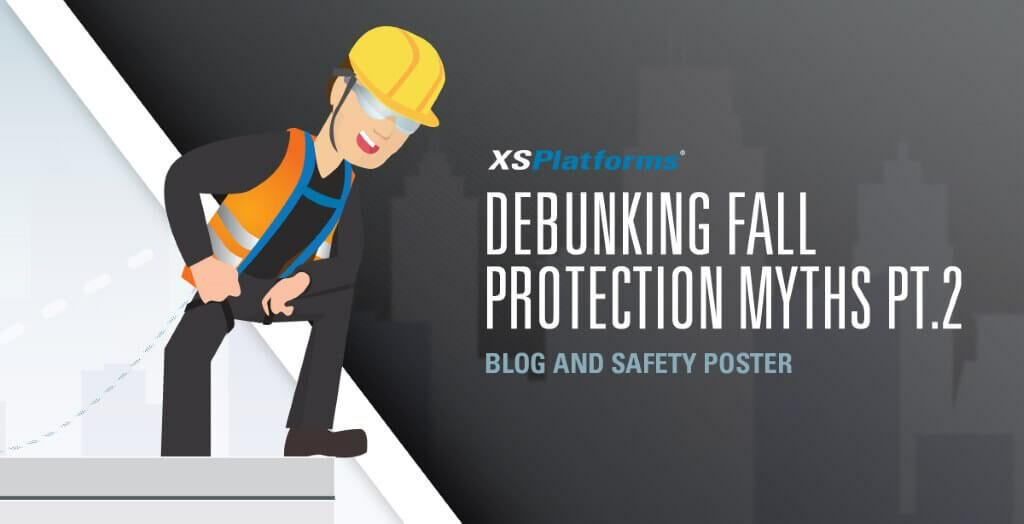
In this second blog we look at another 5 common misconceptions in the world of working at height. These myths need to be debunked, to ensure everyone has the right knowledge to combat dangerous falls from height. Working safely at height is a combination of the right knowledge, the right attitude to safety and the right equipment.
Myth 6: “I’ve inspected my PPE last week, I don’t have to do it again, right?”
Fall protection PPE must be inspected before every use. No matter when the last inspection was, check your products before using them. This means a user can perform a visual inspection in which they look for damages and/or deformations of the materials. Should any irregularities be signaled, stop using the product. For example, if a D-ring of a full body harness shows signs of deformation do not use it. Send the PPE away to a competent person for a check-up. If they determine the product is still safe to use they will return it with a certificate that states it can be used.
Additionally all fall protection PPE needs to be checked and maintained by a competent person annually.
Myth 7: “Calling the emergency services constitutes a rescue plan”
Calling emergency services may not be enough. If your worksite is far away, or if it is a very specialist rescue situation emergency services may not be on time, or may not have adequate resources to perform the rescue.
Where there is work at height, there should be a rescue plan. A rescue plan is made specifically for your worksite. If you have multiple locations this means you’ll have multiple rescue plans. The plan specifies who the designated rescue workers are, where materials can be found and other rescue procedures. Just writing down the emergency service number is not enough. You have to provide quick rescue to prevent further injuries to a person who is hanging in suspension in their full body harness.

Myth 8: “I can react quickly enough during a fall event to minimize injury”
Unfortunately, this is a common misconception. It takes approx. 6 meters (20 feet) before our brains catch up to the fact that we have fallen. At this time it is physically almost impossible to stop your fall. And then we assume you are conscious when you fall.
You should never have to rely on your own physical reflexes to stop a fall. Therefore workers need to use fall protection to either prevent falls all together (fall restraint) or to arrest a fall almost instantly as it happens (fall arrest).
Myth 9: “Health and safety regulations do not benefit me”
We can say with great certainty that health and safety regulations benefit everyone, as they dictate safety measures for workplaces. Regulations have made workplaces much safer and will continue to work towards jobsites free from hazards. Without health and safety regulations a lot more people would sustain injuries at work, or die of the consequences of a workplace accident.
In the United Kingdom it is estimated that 225 people, per year, now get to go home safe, instead of dying at work, due to clearer health and safety requirements.

Myth 10: “All types of fall protection equipment are suitable for all sorts of work”
Fall protection is not a one-size fits all application. Working on a roof requires different equipment than working on a beam in a factory hall. Working in fall restraint (preventing falls from happening) requires different equipment than working in fall arrest (arresting a fall should it occur). Every worksite needs to be evaluated to see what type of fall protection solution suits the situation best. In order to do this a certain understanding of the equipment is necessary during the purchasing stage.
Personal fall protection equipment also needs to be adjusted to the person using it. The user needs to be comfortable in the equipment and feel that it does not hinder their work. Plus the weight of a person and their equipment needs to be considered when purchasing fall protection personal protective equipment. Both harnesses and lanyards have a weight range. Exceeding that range means the system can fail in case a fall occurs. So the equipment will need to be adjusted accordingly.
Spreading facts, not fiction
Working at height is dangerous as people are faced with several forms of fall hazards. Misinformation and myths told among crews have a serious effect on safety. Therefore it’s in the employers best interest to ensure all workers are properly trained for working at height. That way they can recognize hazards themselves, know how to use their equipment properly and know how to separate truth from fiction.
Download the ‘Myths debunked’ posters, print them out and hang them in a visible spot to educate staff. You can also include the myths debunked into a toolbox talk, or use them during a safety stand-down.

1 Comment. Leave new
Thank you for pointing out that fall protection PPE should be inspected before every use, no matter when the last inspection was. When I was growing up there was an accident that involved someone falling from a high place because they hadn’t done the proper inspection. I think that safety equipment inspection is extremely important for all companies to make sure that they do things correctly, but also to ensure that they are protected as well in case of injury of their employee.